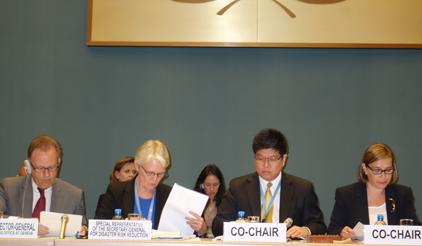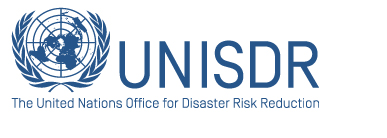 |
|
| |
|

At the opening today of discussions on the Third UN World Conference on Disaster Risk Reduction: The Acting Director General of the UN Office in Geneva, Michael Moller, the Head of UNISDR, Margareta Wahlstrom, Co-chair, Ambassador Thani Thongphakdi, Thailand, and Co-chair, Ambassador, Päivi Kairamo, Finland. (Photo: UNISDR) |
|
By: UNISDR
GENEVA, 14 July 2014 - Preparations for the Third UN World Conference on Disaster Risk Reduction gathered momentum today as more than 600 government representatives and experts from around the world convened in Geneva for the First Session of an Intergovernmental Preparatory Committee.
Experts representing a broad coalition of relevant stakeholders from around the world are attending the two-day preparatory meeting to provide input for an initial draft of a Post-2015 Framework that will seek to reduce disaster losses and put the tenets of disaster risk reduction at the heart of sustainable development. This is the culmination of a process started two years ago and which has involved over 150 consultations worldwide.
|
Margareta Wahlström, the Secretary-General’s Special Representative for Disaster Risk Reduction, recalled today that in December 2013, the United Nations General Assembly decided that the Third World Conference on Disaster Risk Reduction will be held in Sendai, Japan, from 14 to 18 March 2015 and at the highest possible level.
The Conference has the following key objectives: review of the implementation of the Hyogo Framework for Action which was adopted by all UN Member States following the 2005 Indian Ocean tsunami; to adopt a concise, focused, forward-looking and action-oriented post-2015 framework for disaster risk reduction; and to identify modalities of cooperation based on commitments to implement a post-2015 framework for disaster risk reduction.
While the HFA has had much success in reducing loss of lives and spreading a global culture of disaster risk reduction, economic losses now regularly exceed $100 billion annually and are projected to double by 2030. Over the last 30 years, risk of economic loss due to floods has increased by over 160 per cent and to tropical cyclones by 265 per cent. Economic loss risk to floods and cyclones in OECD countries is growing faster than GDP per capita.
Ms. Wahlström outlined the clear guidance which has been received to date for consideration in drafting a new Post-2015 framework for disaster risk reduction:
Build on the HFA; focus more on preventing the creation of new risk and continue steady action to reduce existing risk; focus on reducing vulnerability and exposure; engage the whole of society and promote equality, inclusion and non-discriminatory participation; and develop more effective financing mechanisms in both public and private sectors for managing risk.
Ms. Wahlström also highlighted the need for synergies across the three key post 2015 frameworks (the post-2015 framework on disaster risk reduction, the sustainable development goals and a renewed agreement on climate change) . “We know that the lack of coherence in policies and approaches is in itself a risk driver; strengthen national governance and coordination to manage disaster risk,” she said.
She also stressed the importance of engaging all State institutions; empowering local communities and authorities in managing disaster risk and contributing to the definition of national policies and plans; and more clearly defining responsibilities across public and private sector actors.
In welcoming participants, Michael Møller, acting Director-General of the UN Office in Geneva, said that the committee had an important role to plan to “set the course for a resilient future”.
Ambassador Päivi Kairamo (Finland) and Ambassador Thani Thongphakdi (Thailand) were elected co-chairs of the committee meeting by acclamation.
Ambassador Kairamo noted that all countries without exception are now vulnerable to the risks posed by natural disasters and climate change. “With the Hyogo Framework now up for review in 2015, the international community can now develop a post-2015 framework …that incorporates new elements that can lift the work of reducing disaster risk to a new level,” she said.
Ambassador Thongphakdi invited the committee to “maintain the energy and drive shown by participants at the regional platforms and meetings, and aim for the same standard of quality and integrity.”
In view of the immense challenges involved, Ambassador Kenichi Suganuma of Japan urged UN member States to ensure high-level participation at the World Conference in Sendai. He also outlined local preparations and facilities for hosting the event and recalled that Japan had already hosted the world conferences on disaster reduction in 1994 in Yokohama and in 2005 in Kobe, Hyogo.
Speakers representing the Africa, Asia, Middle East and Latin America regions summarized the work of their recent regional platform consultations and stressed the importance of including their main outcomes in the post-2015 global framework. A series of speakers from more than 20 States then outlined progress in implementing the Hyogo Framework in their respective countries and underlined the importance of building on it.
All speakers agreed that the Hyogo Framework has helped lay the foundations for the 21st century battle against natural hazards and climate change impacts but implementation was still a work in progress.
India’s Ambassador, Dilip Sinha, said India greatly benefited from the HFA moving from a relief-centric to more holistic approach encompassing disaster risk reduction and early warning systems. He cited the example of Cyclone Phailin in 2013 which resulted in 45 casualties even though it was the second strongest tropical cyclone ever to make landfall in India; over 1.2 m people were evacuated and brought to safety. He said the HFA priorities are a work in progress and the new framework should build on that.
Mexico’s Ambassador, Jorge Lomonaco, said, it is necessary that we have a framework inspired by the HFA and one which is markedly preventive. Prevention should be the basis of it and government should take the leadership on implementation.
Senegal Ambassador, Dame Gaye, said the priorities of the HFA need to be maintained and that in developing countries the priorities are not completed. He suggested a global fund for disaster risk reduction fed by voluntary contributions. Mr. Gaye also recommended a time-frame of 15 years for the next framework.
Egypt Ambassador, Walid M. Abdelnasser, speaking on behalf of the African Group, remarked on the fact that there are huge differences between developed and developing countries in terms of implementation capacity. He said there need to be an enabling environment internationally to provide support to vulnerable countries especially in Africa. He stressed the importance of integrating disaster risk reduction and climate change adaptation, particularly through improved data collection.
Sweden’s Ambassador Hans Lundborg, said it was important to build on the success of the existing framework and to ensure alignment with SDGS and climate agenda. He also said it was important to strengthen the gender perspective in the new framework and to made it more inclusive.
The committee is reviewing a paper on “suggested elements” for inclusion in the post-2015 framework based on consultations and inputs from many agencies, governments and stakeholders around the world.
A Bureau to guide the work of the Preparatory Committee consisting of two members of each regional group and an ex officio member represented by Japan was elected. The next Preparatory Committee meeting is scheduled to take place in from 17 to 18 November 2014.
- Date:
- 14 Jul 2014
- Sources:
-
- United Nations Office for Disaster Risk Reduction (UNISDR)
Related Links
Keywords
- Themes:
- Governance
- Regions:
- Africa, Americas, Europe, Asia, Oceania
|
|
|




